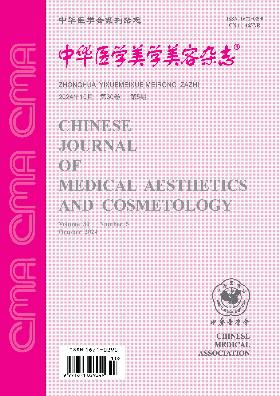不同强度水射流力对自体脂肪吸出活力的影响:体外研究
引用次数: 0
摘要
目的观察不同强度的水射流力对自体脂肪移植物存活率的影响。方法对12例在我科行水射流辅助腹部抽脂术的女性患者进行抽脂。根据水射流力的强弱将实验组分为4个亚组:R1(压力,30 bar)、R2(压力,50 bar)、R3(压力,70 bar)和R4(压力,90 bar)。c组采用手持抽吸作为对照组,棉垫过滤脂肪组织,低速离心,观察各组水脂肪组织组成比。Calcein-AM/Hoechst 33342染色检测脂肪细胞活力。结果抽吸脂肪分为油层、纯脂肪组织、液体和底泥四层。石油的比率R1、R2、R3、R4和C(8.9±2.3)%,(9.6±2.1)%,(10.3±1.3)%,(14.2±1.6)%和(9.5±1.8)%,分别。R1、R2、R3与C (P < 0.05)之间差异无统计学意义。05)。R4组与其他组比较,差异有统计学意义(p0.05)。R3、R4、C之间差异有统计学意义(P<0.05)。结论低强度水射流(R1, R2)下脂肪移植体存活率高于高强度水射流(R3, R4)下脂肪移植体存活率。关键词:乳房美容;移植;腹部脂肪;喷水系统;Calcein-AM/Hoechst 33342染色;水射流力强度本文章由计算机程序翻译,如有差异,请以英文原文为准。
Influence of varying intensities of water-jet force on autologous fat draft viability: an in-vitro study
Objective
To observe the effect of varying intensities of water-jet force on autologous fat graft viability.
Methods
Lipoaspirate was taken from 12 female patients undergoing water-jet assisted abdominal liposuction at our department. According to the intensity of water-jet force, the experimental group was divided into four subgroups: R1 (pressure, 30 bar), R2 (pressure, 50 bar), R3 (pressure, 70 bar) and R4 (pressure, 90 bar). Hand-held suction was taken as the control group C. Adipose tissue was filtered with cotton cushion and centrifuged at low speed, and the composition ratio of water and fat tissue from each group was observed. Calcein-AM/Hoechst 33342 staining was used to detect the viability of adipocytes.
Results
Fat aspirates was divided into four layers: oil layer, pure fat tissue, liquid and bottom sediment. Oil ratios of R1, R2, R3, R4 and C were (8.9±2.3)%, (9.6±2.1)%, (10.3±1.3)%, (14.2±1.6)% and (9.5±1.8)%, respectively. There was no statistically significant difference between R1, R2, R3 and C (P>0. 05). Statistically significant difference was found between R4 and other groups (P 0.05). Statistically significant difference was found between R3, R4 and C (P<0.05).
Conclusions
Viability of fat graft harvested under lower intensity of water-jet force (R1, R2) is higher than that harvested under higher intensity of water-jet force (R3, R4).
Key words:
Breast Beauty; Transplantation; Abdominal fat; Water-jet system; Calcein-AM/Hoechst 33342 staining; Intensity of water-jet force
求助全文
通过发布文献求助,成功后即可免费获取论文全文。
去求助
来源期刊
自引率
0.00%
发文量
4641
期刊介绍:
"Chinese Journal of Medical Aesthetics and Cosmetology" is a high-end academic journal focusing on the basic theoretical research and clinical application of medical aesthetics and cosmetology. In March 2002, it was included in the statistical source journals of Chinese scientific and technological papers of the Ministry of Science and Technology, and has been included in the full-text retrieval system of "China Journal Network", "Chinese Academic Journals (CD-ROM Edition)" and "China Academic Journals Comprehensive Evaluation Database". Publishes research and applications in cosmetic surgery, cosmetic dermatology, cosmetic dentistry, cosmetic internal medicine, physical cosmetology, drug cosmetology, traditional Chinese medicine cosmetology and beauty care. Columns include: clinical treatises, experimental research, medical aesthetics, experience summaries, case reports, technological innovations, reviews, lectures, etc.

 求助内容:
求助内容: 应助结果提醒方式:
应助结果提醒方式:


